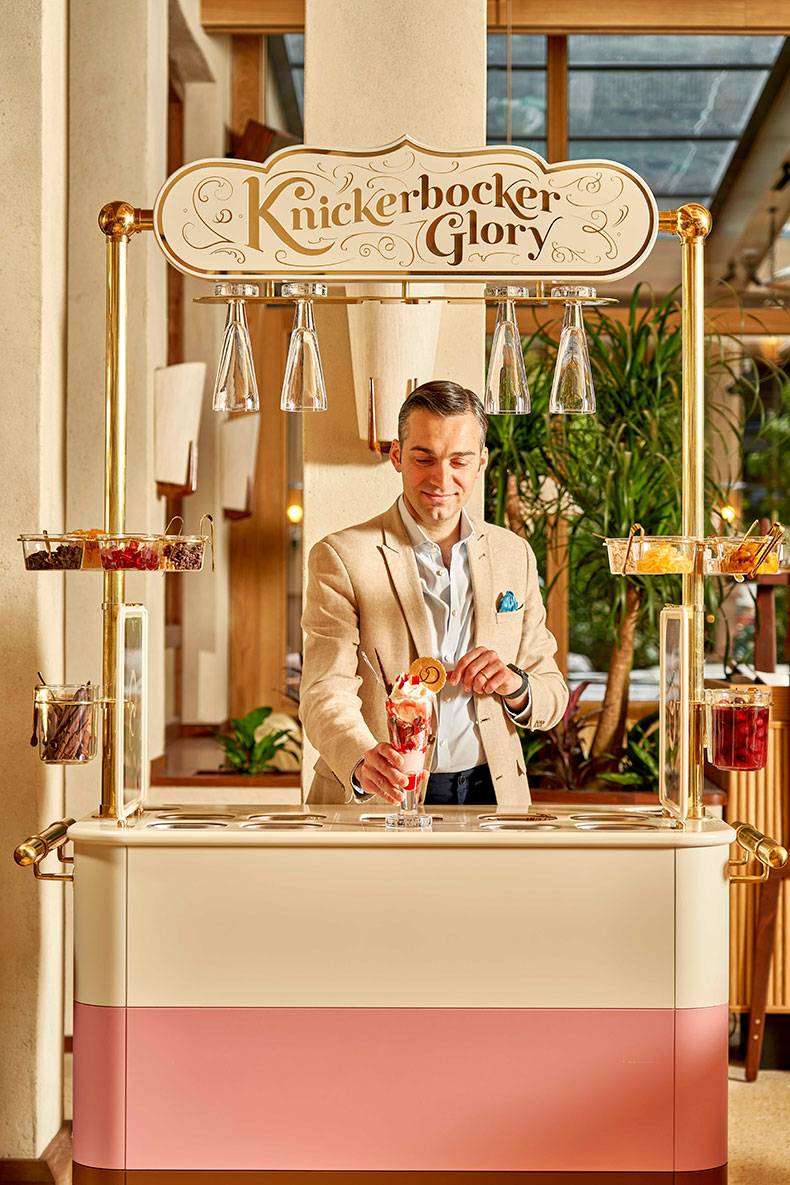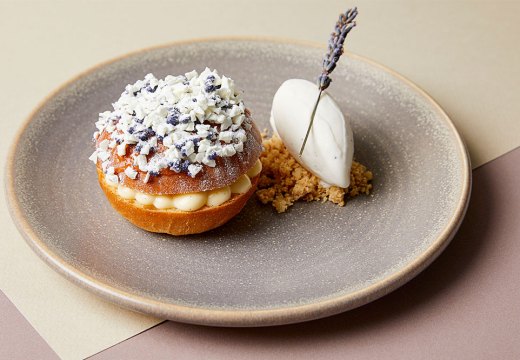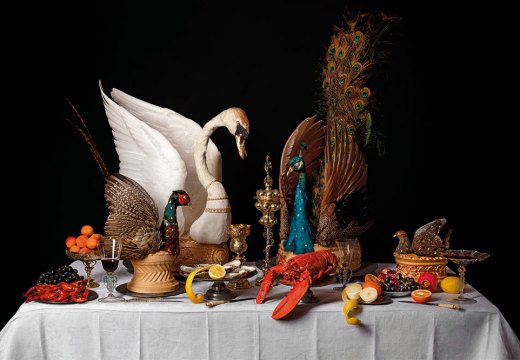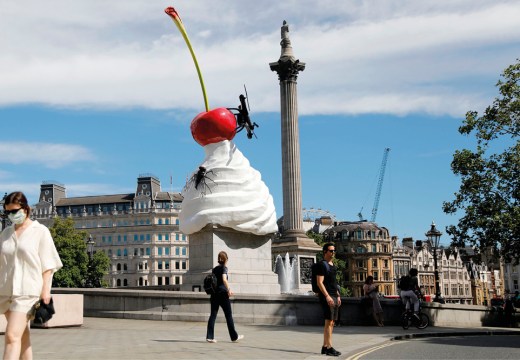From the September 2023 issue of Apollo. Preview and subscribe here.
An advertisement for Bird’s Custard that is now in the V&A’s print collection shows a young boy in a parlour with a grin on his face that at once suggests pleasure and a sense of wrongdoing. Behind him, peering round the side of a chair is, presumably, his grandmother, looking at the boy with an indulgent relish that only a relation of one remove can muster at the sight of transgression. The boy is leaning over a trolley and eating his way through cups of custard – who knows if he will make it to the jellies, blancmanges and other treats on the two lower levels of the trolley? At the bottom of the advert is the word ‘Irresistible!’
Reading this more than a century after it was written, it seems it might not be just the custard that is being referred to. Alfred Bird invented his egg-free custard in 1837 so that his egg-allergic wife could enjoy the dessert. But it was not until later in the 19th century that his, or indeed anybody’s, puddings were being served from trolleys. The move was partly motivated by the shift from service à la Française (all food on the table at the same time) to service à la Russe (food appearing by course) that started in 1810. Gueridon service from a trolley – which included the business of carving and flambéeing as well as the opportunity to get lost in the thickets of Black Forest gateau – was a way for restaurants to add drama and suggest luxury while adhering to the formality of courses. It was also a way for restaurants to show off their wares and seduce diners into ordering more. At home, it was a way of bringing in tea and cakes with fewer servants. Clearly, the trolley was irresistible.
In Elizabeth Taylor’s novel Mrs Palfrey at the Claremont (1971), the sweet trolley has associations of faded grandeur. Mrs Palfrey, recently widowed, moves in to the Claremont, a residential hotel in central London inhabited by the genteel elderly. In the hotel restaurant, after the very blanched start of the meal (‘pasty celery soup’, followed by ‘cold turkey’ or ‘Surrey fowl’) there comes a splash of colour: ‘Then the trolley was wheeled around with its load of wobbling red jellies, slopping fruit salad (mostly, Mrs Palfrey noted, sliced apples and bananas).’ It is a far cry from the glistening pleasures recounted by Denton Welch 30 years earlier in In Youth is Pleasure (1945). The author’s alter ego stumbles into a hotel where waiters ‘trundled chromium trolleys, with glass shelves, on which brilliant little cakes were piled […] His eyes were already eating them up as the man steered the trolley towards him.’

Victoria and Albert Museum, London
The flash of chromium sets this trolley firmly in the world of art deco chic: it was in the mid 20th century that designers reshaped and added flourishes to food trolleys to bring them into the modern world. Designers such as Alvar Aalto and Jean Royère put their personal stamp on the trolley – from fluid Nordic plywood to insouciant gilded cubes. Jacques Adnet created so many trolleys he might be responsible for many people’s idea of what one looks like. In 1955, the architect Josef Frank, now better known for his very recognisable fabric patterns, designed a glamorous three-wheeled trolley that is all fluid lines in brass and weightless-looking glass. It is as though these trolleys were compensating for the less elaborate look of early 20th-century food.
It is possible that the greatest dessert trolley in London can be found in Oslo Court, a residential block just north of Regent’s Park built in the late 1930s and designed by Robert Atkinson, who also designed the Barber Institute of Fine Arts in Birmingham. The artistry in this building, however, is most obvious in the restaurant on the ground floor where, to much delight, a trolley laden with profiteroles, caramelised oranges and trifle is wheeled between tables covered in salmon pink cloths. It is a more robust and creamy affair than the pared back simplicity of, say, the sweet trolley at Ballymaloe House in County Cork, carefully orchestrated by pastry chef J.R. Ryall to ensure that only the season’s finest produce is on show. But somehow, the very fact that these puddings are presented on a trolley makes them feel more exciting.

Apollo 11, the Knickerbocker Glory trolley at Dovetale, 1 Hotel Mayfair. Courtesy Dovetale
Restaurant critics periodically make a plea for the return of the dessert trolley. At this stage of the 21st century that might be going too far. It seems unlikely that domestic cooks are about to stretch to making a range of puddings just to fill up a trolley – with staff shortages in the catering sector, pastry sections are often the first parts of a kitchen to feel the cool wind of reduction in professional arenas. One new opening is bucking the trend, though. Dovetale, a clearly Michelin-aspirant restaurant, has recently opened as part of 1 Hotel Mayfair under the aegis of chef Tom Sellers, whose other restaurant, Story, on Tooley Street near London Bridge, is famous both for his food and its presentation. Dovetale has made a big deal out of its trolleys dedicated to knickerbocker glories. Designed by Seymourpowell, who were responsible for the interiors of Virgin Galactic’s spaceships, the trolleys – named Apollo 11 and Apollo 13 – are large, and come with inbuilt cooling areas for the ice cream. Sellers describes the trolleys as ‘opulent… it feels more personable and – even more importantly – it’s fun.’ Somehow, though, for all the space-age overtones, this is not the fun of the future, a fact emphasised by the choice of the knickerbocker glory, a star of the early 1900s whose splendour and relevance have perhaps faded. It is a shift from glamour to nostalgia, closer to Mrs Palfrey’s world than Denton Welch’s. But perhaps that is where we are heading right now, both in the kitchen and beyond.
From the September 2023 issue of Apollo. Preview and subscribe here.
Unlimited access from just $16 every 3 months
Subscribe to get unlimited and exclusive access to the top art stories, interviews and exhibition reviews.














![Masterpiece [Re]discovery 2022. Photo: Ben Fisher Photography, courtesy of Masterpiece London](http://www.apollo-magazine.com/wp-content/uploads/2022/07/MPL2022_4263.jpg)
It’s time for the government of London to return to its rightful home